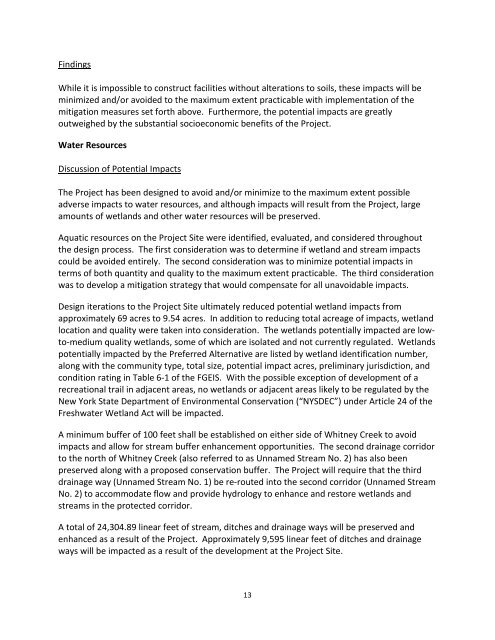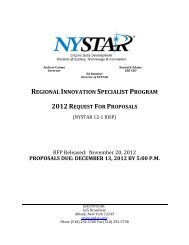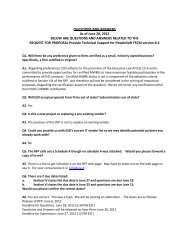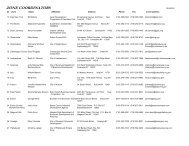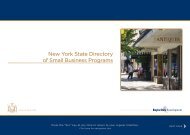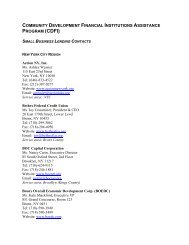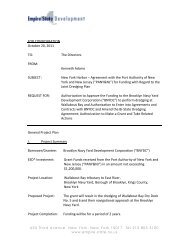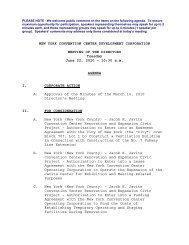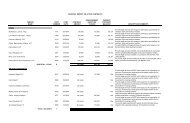NEW YORK STATE URBAN DEVELOPMENT CORPORATION d/b/a ...
NEW YORK STATE URBAN DEVELOPMENT CORPORATION d/b/a ...
NEW YORK STATE URBAN DEVELOPMENT CORPORATION d/b/a ...
You also want an ePaper? Increase the reach of your titles
YUMPU automatically turns print PDFs into web optimized ePapers that Google loves.
Findings<br />
While it is impossible to construct facilities without alterations to soils, these impacts will be<br />
minimized and/or avoided to the maximum extent practicable with implementation of the<br />
mitigation measures set forth above. Furthermore, the potential impacts are greatly<br />
outweighed by the substantial socioeconomic benefits of the Project.<br />
Water Resources<br />
Discussion of Potential Impacts<br />
The Project has been designed to avoid and/or minimize to the maximum extent possible<br />
adverse impacts to water resources, and although impacts will result from the Project, large<br />
amounts of wetlands and other water resources will be preserved.<br />
Aquatic resources on the Project Site were identified, evaluated, and considered throughout<br />
the design process. The first consideration was to determine if wetland and stream impacts<br />
could be avoided entirely. The second consideration was to minimize potential impacts in<br />
terms of both quantity and quality to the maximum extent practicable. The third consideration<br />
was to develop a mitigation strategy that would compensate for all unavoidable impacts.<br />
Design iterations to the Project Site ultimately reduced potential wetland impacts from<br />
approximately 69 acres to 9.54 acres. In addition to reducing total acreage of impacts, wetland<br />
location and quality were taken into consideration. The wetlands potentially impacted are lowto-medium<br />
quality wetlands, some of which are isolated and not currently regulated. Wetlands<br />
potentially impacted by the Preferred Alternative are listed by wetland identification number,<br />
along with the community type, total size, potential impact acres, preliminary jurisdiction, and<br />
condition rating in Table 6-1 of the FGEIS. With the possible exception of development of a<br />
recreational trail in adjacent areas, no wetlands or adjacent areas likely to be regulated by the<br />
New York State Department of Environmental Conservation (“NYSDEC”) under Article 24 of the<br />
Freshwater Wetland Act will be impacted.<br />
A minimum buffer of 100 feet shall be established on either side of Whitney Creek to avoid<br />
impacts and allow for stream buffer enhancement opportunities. The second drainage corridor<br />
to the north of Whitney Creek (also referred to as Unnamed Stream No. 2) has also been<br />
preserved along with a proposed conservation buffer. The Project will require that the third<br />
drainage way (Unnamed Stream No. 1) be re-routed into the second corridor (Unnamed Stream<br />
No. 2) to accommodate flow and provide hydrology to enhance and restore wetlands and<br />
streams in the protected corridor.<br />
A total of 24,304.89 linear feet of stream, ditches and drainage ways will be preserved and<br />
enhanced as a result of the Project. Approximately 9,595 linear feet of ditches and drainage<br />
ways will be impacted as a result of the development at the Project Site.<br />
13


